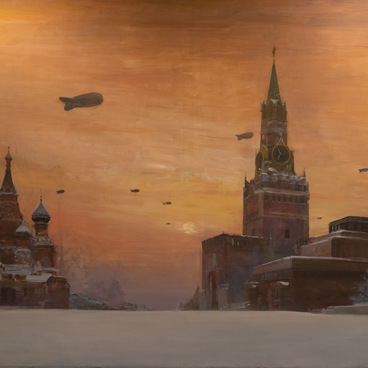The exhibition “The Feat of the Army” is dedicated to the most significant events of the Great Patriotic War. The painting by Vladimir Molchanov depicts the Battle at Borodino Field. In 1941, fierce fighting between the Soviet forces and the German invaders took place on this field.
In the summer of 1941, Soviet forces started constructing fortifications on the Mozhaisk defense line near Moscow, including the areas of Volokolamsk, Mozhaisk, Maloyaroslavets, and Kaluga. In early October, Hitler’s troops started the offensive toward Moscow. One of the main attacks was directed at the Mozhaisk area. This was where the 5th Army of General Dmitry Lelyushenko was holding the line. The Mozhaisk highway itself was defended by the 32nd Rifle Division of Colonel Viktor Polosukhin supported by the depleted forces of the tank brigades which had fought to the bitter end near Gzhatsk. The Soviet forces were fighting against the 40th motorized corps including the full 10th Panzer Division, the SS Panzer Division “Das Reich” and the 7th Infantry Division which attacked along the Minsk highway.
On October 12, the enemy’s advanced forces reached the 125th kilometer of the Minsk highway near the village of Yelnya where they were met by the 17th Rifle Regiment. In this first battle, six German tanks were destroyed. The enemy made repeated attempts to capture the village and break through along the Minsk highway. Soviet commanders threw reserve troops into the battle, including a troop of border guards, two anti-tank artillery regiments, and a battalion of Katyusha rocket launchers. The main result of these battles was that the 32nd Division managed to stop the German forces and hold the line for almost a week, providing the opportunity and time to move up the reserves and organize a new line of defense. After several days of fierce fighting, the enemy managed to break through to Mozhaisk and capture the city. The offensive was brought to a halt near Dorokhovo. It was completely stopped at the 75th kilometer of the Minsk highway along the line between Kubinka and Naro-Fominsk.
In January 1942, the Red Army recaptured Mozhaisk and Borodino Field.
In the summer of 1941, Soviet forces started constructing fortifications on the Mozhaisk defense line near Moscow, including the areas of Volokolamsk, Mozhaisk, Maloyaroslavets, and Kaluga. In early October, Hitler’s troops started the offensive toward Moscow. One of the main attacks was directed at the Mozhaisk area. This was where the 5th Army of General Dmitry Lelyushenko was holding the line. The Mozhaisk highway itself was defended by the 32nd Rifle Division of Colonel Viktor Polosukhin supported by the depleted forces of the tank brigades which had fought to the bitter end near Gzhatsk. The Soviet forces were fighting against the 40th motorized corps including the full 10th Panzer Division, the SS Panzer Division “Das Reich” and the 7th Infantry Division which attacked along the Minsk highway.
On October 12, the enemy’s advanced forces reached the 125th kilometer of the Minsk highway near the village of Yelnya where they were met by the 17th Rifle Regiment. In this first battle, six German tanks were destroyed. The enemy made repeated attempts to capture the village and break through along the Minsk highway. Soviet commanders threw reserve troops into the battle, including a troop of border guards, two anti-tank artillery regiments, and a battalion of Katyusha rocket launchers. The main result of these battles was that the 32nd Division managed to stop the German forces and hold the line for almost a week, providing the opportunity and time to move up the reserves and organize a new line of defense. After several days of fierce fighting, the enemy managed to break through to Mozhaisk and capture the city. The offensive was brought to a halt near Dorokhovo. It was completely stopped at the 75th kilometer of the Minsk highway along the line between Kubinka and Naro-Fominsk.
In January 1942, the Red Army recaptured Mozhaisk and Borodino Field.


